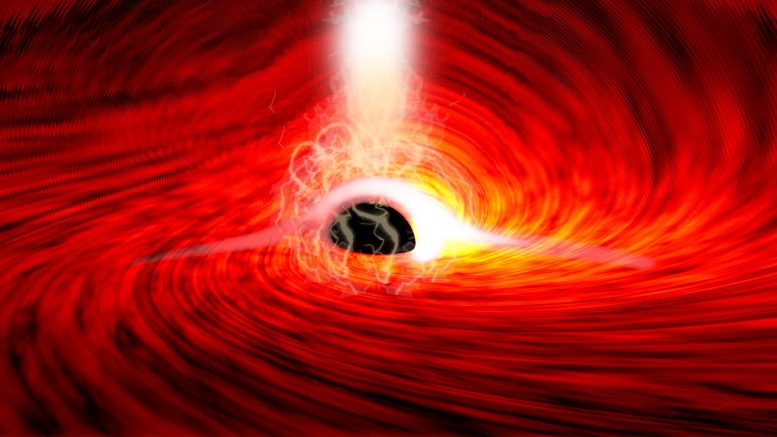
Researchers observed bright flares of X-ray emissions, produced as gas falls into a supermassive black hole. The flares echoed off of the gas falling into the black hole, and as the flares were subsiding, short flashes of X-rays were seen – corresponding to the reflection of the flares from the far side of the disk, bent around the black hole by its strong gravitational field. Credit: Dan Wilkins
First Detection of Light From Behind a Black Hole
Watching X-rays flung out into the universe by the supermassive black hole at the center of a galaxy 800 million light-years away, Stanford University astrophysicist Dan Wilkins noticed an intriguing pattern. He observed a series of bright flares of X-rays – exciting, but not unprecedented – and then, the telescopes recorded something unexpected: additional flashes of X-rays that were smaller, later and of different “colors” than the bright flares.
According to theory, these luminous echoes were consistent with X-rays reflected from behind the black hole – but even a basic understanding of black holes tells us that is a strange place for light to come from.
“Any light that goes into that black hole doesn’t come out, so we shouldn’t be able to see anything that’s behind the black hole,” said Wilkins, who is a research scientist at the Kavli Institute for Particle Astrophysics and Cosmology at Stanford and SLAC National Accelerator Laboratory. It is another strange characteristic of the black hole, however, that makes this observation possible. “The reason we can see that is because that black hole is warping space, bending light and twisting magnetic fields around itself,” Wilkins explained.
The strange discovery, detailed in a paper published today (July 28, 2021) in Nature, is the first direct observation of light from behind a black hole – a scenario that was predicted by Einstein’s theory of general relativity but never confirmed, until now.
“Fifty years ago, when astrophysicists starting speculating about how the magnetic field might behave close to a black hole, they had no idea that one day we might have the techniques to observe this directly and see Einstein’s general theory of relativity in action,” said Roger Blandford, a co-author of the paper who is the Luke Blossom Professor in the School of Humanities and Sciences and Stanford and SLAC professor of physics and particle physics.
How to see a black hole
The original motivation behind this research was to learn more about a mysterious feature of certain black holes, called a corona. Material falling into a supermassive black hole powers the brightest continuous sources of light in the universe, and as it does so, forms a corona around the black hole. This light – which is X-ray light – can be analyzed to map and characterize a black hole.
The leading theory for what a corona is starts with gas sliding into the black hole where it superheats to millions of degrees. At that temperature, electrons separate from atoms, creating a magnetized plasma. Caught up in the powerful spin of the black hole, the magnetic field arcs so high above the black hole, and twirls about itself so much, that it eventually breaks altogether – a situation so reminiscent of what happens around our own Sun that it borrowed the name “corona.”
“This magnetic field getting tied up and then snapping close to the black hole heats everything around it and produces these high energy electrons that then go on to produce the X-rays,” said Wilkins.
As Wilkins took a closer look to investigate the origin of the flares, he saw a series of smaller flashes. These, the researchers determined, are the same X-ray flares but reflected from the back of the disk – a first glimpse at the far side of a black hole.
“I’ve been building theoretical predictions of how these echoes appear to us for a few years,” said Wilkins. “I’d already seen them in the theory I’ve been developing, so once I saw them in the telescope observations, I could figure out the connection.”
Future observations
The mission to characterize and understand coronas continues and will require more observation. Part of that future will be the European Space Agency’s X-ray observatory, Athena (Advanced Telescope for High-ENergy Astrophysics). As a member of the lab of Steve Allen, professor of physics at Stanford and of particle physics and astrophysics at SLAC, Wilkins is helping to develop part of the Wide Field Imager detector for Athena.
“It’s got a much bigger mirror than we’ve ever had on an X-ray telescope and it’s going to let us get higher resolution looks in much shorter observation times,” said Wilkins. “So, the picture we are starting to get from the data at the moment is going to become much clearer with these new observatories.”
Reference: “Light bending and X-ray echoes from behind a supermassive black hole” by D. R. Wilkins, L. C. Gallo, E. Costantini, W. N. Brandt and R. D. Blandford, 28 July 2021, Nature.
DOI: 10.1038/s41586-021-03667-0
Co-authors of this research are from Saint Mary’s University (Canada), Netherlands Institute for Space Research (SRON), University of Amsterdam and The Pennsylvania State University.
This work was supported by the NASA NuSTAR and XMM-Newton Guest Observer programs, a Kavli Fellowship at Stanford University, and the V.M. Willaman Endowment at the Pennsylvania State University.

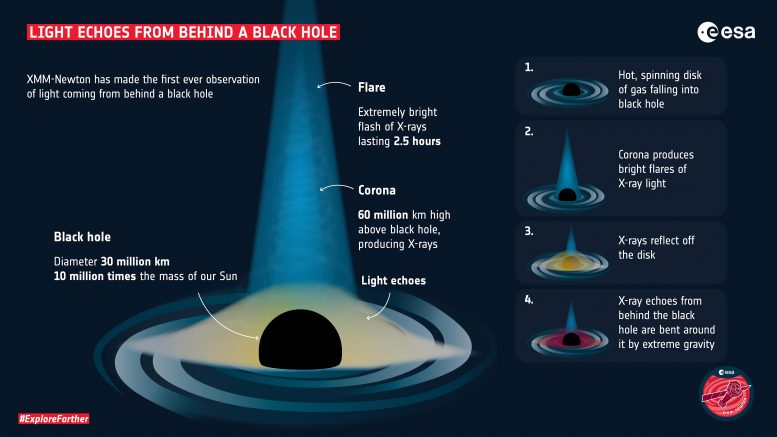
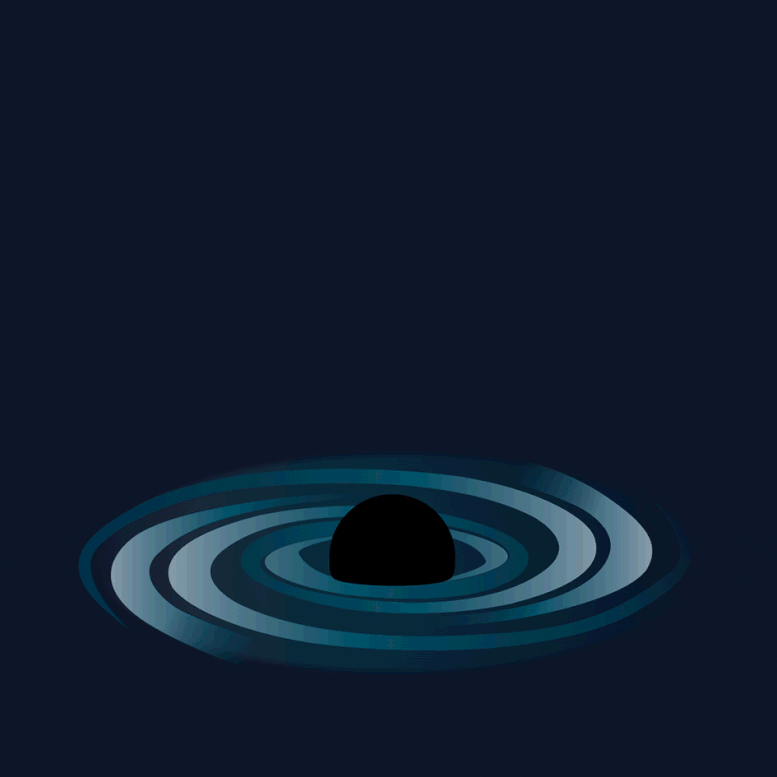
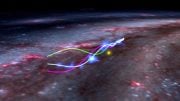



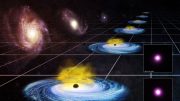



How sad it is that our time is still as dark as Copernicus time! The so obvious mistake of relativity is still not be seen by the mainstream physicists, even though I have pointed it out for so many times:
Einstein uses Lorentz Transformation to have redefined time and space and the newly defined time is no longer the time of physical clocks which is still absolute in relativity. All so called relativistic effects are just from this mistake: equating relativistic time and clock time.
Special relativity tells us that the relativistic time of the moving frame becomes shorter than the relativistic time of the stationary frame. Mainstream physicists immediately conclude that all physical processes in the moving frame are becoming slower, but they forget that in relativity, the changes of physical processes are the products of relativistic time and relativistic changing rates. As relativistic time of moving frame becomes shorter, the relativistic changing rates become faster, their relativistic effects cancel each other to make the the products of the relativistic time and relativistic changing rates of the moving frame always the same as the products of relativistic time and relativistic changing rates of the stationary frame. That is, the so-called relativistic effects are just mathematical games which won’t happen in any physical process.
Thanks internet rando, your correction of the theory that has stood every test thrown against it by people who have spent their lives studying it is appreciated.
All the so-called relativistic effects such as the lives of muons, the corrections of atomic clocks on the GPS satellites are misinterpretations of other effects because they are all absolute changes. The average life spans of muons is also a product of the relativistic time and average relativistic aging rate, which won’t change due to the change of the reference frame. The extended life spans of muons is absolute caused by other factors such as the resistance of aether. The atomic clock uses the recorded number of periods to calculate the elapsed time, and the number of periods is the product of relativistic time and relativistic frequency, which is also independent of reference frame in special relativity because the decrease of the length of relativistic time of the moving frame is canceled by the increase of the frequency of the moving frame in the product.
I agree with you, Xinhang. Einstein’s relativity theories tried to describe relativistic effects as time and space variations. This is a very unwieldy way of describing relativistic physics, because space and time got so convoluted and lost their meaningful physical origins. To say it another way, in his theories, time and space are no longer a underlying physical structure of the universe, they are not viewed as true physical properties, but rather the distorted secondary image of the physical properties. This immediately hinders the understanding of the universe because it is difficult to judge proper physics through the warped space and time. A very simple example: if space is contracted, then time will be shortened due to constant speed of light, then when time is shortened, space will be further contracted due to constant speed of light, and then it is a deeper loop. So it must force a artificial rule to apply either space contraction or time dilation, only once, not twice or further. But this immediately contradicts the general relativity because both space and time are warped through the equation.
In summary, we should not touch time and space, we should only describe relativity effects through other means as a result of space and time. For example, general relativity and special relativity can be described by one single multiplicative equation, which I have developed without introducing time dilation, space contraction or spacetime warping. The theory doesn’t accept the idea that aging is slower in a moving frame, and it doesn’t think light will be warped or trapped by black holes. Light just go straight lines in vacuum at constant speed of light. No lensing or bending.
I would love to know your thoughts on another topic, the math amn India boy did years ago that could produce 5 dimension solar cells enabling the solar panels to capture more light.
The predictive prowess of General Relativity is there to be seen for all!!
Kvantnost mikrofizičkog svijeta ne proizlazi iz našeg objektivnog znanja i promatranja, kao što je nezavisna od našeg subjektivnog neznanja, ali ako je jednaka svjetlosnom, elektomagnetnom fotonu, kao i mionu, elektronu, i protonu,i neutronu, tako mi kvantnost protona, ili neutrona ne ćemo moči determinirati bez da odredimo kvantnost fotona, i sve virtualnosti, koje nam promatranje bez prepoznavanja pogrešaka virtualizacije, uključuje u mjerenja. Dakle interferometri s ogledalom i polupropusnim ogledalom trebaju imati sve elemente duboko ohlađene da se smanje smetnje temperaturnih oscilacija, ali još ostaje tunel efekt koji sliku refleksije i polupropusnosti rastavlja na milijarde mogučih s možda ne koherentnim pogrešnim pomakom i faktor greškom mjerenja. Mi dakle mjerenja gravitaciono valnih frekvencija trebamo vršiti s dvovalnim izvorom i dvovalnom slikom za analizu uz mogućnost procijene faktorske greške za svaku korištenu frekvenciju, i izbor optimalne faktorske korekcije.
Though theory of relativity has no meaning for other galaxies due to lack of consistency with direction (rotation) vector and nonsingularity of time.Yet law of mass and its effect for bending of light is possible due to its own virtue even when theory of relativity faiĺs.
Theory of relativity is applicable to sole singularity.Different gaĺaxies differ through rotation vector makes Einstein’s theory fake.But law of mass still works can beobserved.So,in round about way present result is good.
It’s kinda sad that after 100 years or so, we still don’t see the absurdity of the relativity theory.
And your math to back this up is …where?
Appealing to authority Ross…? By your standards for seeking true knkwledge , we should still be faithful to Newton, who after all spent his life doing science…? But still SOME of Newton laws and discoveries hold to this day, some might say…Precisely.
Besides, what about the recent map of the universe that shows it being smoother than Relativity calls for? Even a scientist of renown , like Carlos Frenk said after seeing it, that it “frightened” him that his life’s work expanding on Einstein’s Relativity formulas might be wrong .
JUST REMEMBER ROSS THAT SOCRATES SAID THAT “ALL I KNOW IS HOW LITTLE I KNOW”.
Who denies that today’s scientism faithers arent as dogmatic and much of a believers as Mormons,for example Ross…?
NO ABSOLUTES THAT YOU SHOULD TRUST IN AND CLAIM AS TRUTH, BUT THE ABSOLUTE GREATNESS OF GOD, OUR CREATOR WHO MADE IT ALL, OUT OF THE OVER FLOWING LOVE OF HIS HEART, THAT HE LATER PROVED BY HIS LIFE OF LOVING EVERYONE AND DOING ONLY GOOD TO ALL, TILL DYING ON A CROSS AND THEN RISING FROM THE DEAD. . The rest are all fallible, mere mortals who don’t even know what ther next thought might be nor where it will comes from…All that said, keep up your interest in Science, a la Galileo. That is good indeed…Shema!!!
Total bull s.. T Einstein was a Mason not to be trusted all reversed
Science has moved beyond the Cosmology taught in most colleges today. The sun is NOT a nuclear furnace doomed to burn out someday. It is an electrical node in an electrically connected universe. Black Holes are science fiction, invented to solve mathematical problems with the INCORRECT assumptions upon which the science of yesteryear was founded. If YOU would like to get up to speed on leading edge science which does a MUCH better job of explaining what we see in the sky, and predicting what will occur, then you need to study about the “Electric Universe”. These pictures of so call Black Holes, are Plasmoids. Check it out on YouTube, the Thunderbolts Project.
Pure pseudoscience, not luring anyone else.
Here is a recent similar result [ https://iopscience.iop.org/article/10.3847/1538-4357/ab7afc ]:
“The key result of our modeling is that the reflection spectrum in the very soft state is best explained by disk self-irradiation, i.e., photons from the inner disk are bent by the strong gravity of the black hole and reflected off the disk surface. This is the first known detection of thermal disk radiation reflecting off the inner disk.”
From the paper [ https://arxiv.org…6892.pdf ] Methods section:
“The emissivity profile then flattens out to a radius of 15 ‘ , before falling off as approximately “2 over the outer disk, in agreement with the predictions of a model in which the corona consists of a bright, rapidly variable core in addition to a component that extends over the inner parts of the disk [9].”
“With this reflection model, the measured time lag suggests reverberation from a corona at height 4.3 +1.7/-1.1 r_g.”
Here is a recent similar result [ https://iopscience.iop.org/article/10.3847/1538-4357/ab7afc ]:
“The key result of our modeling is that the reflection spectrum in the very soft state is best explained by disk self-irradiation, i.e., photons from the inner disk are bent by the strong gravity of the black hole and reflected off the disk surface. This is the first known detection of thermal disk radiation reflecting off the inner disk.”
From the paper [ https://arxiv.org/pdf/2002.06892.pdf ] Methods section:
“The emissivity profile then flattens out to a radius of 15 ‘ , before falling off as approximately “2 over the outer disk, in agreement with the predictions of a model in which the corona consists of a bright, rapidly variable core in addition to a component that extends over the inner parts of the disk [9].”
“With this reflection model, the measured time lag suggests reverberation from a corona at height 4.3 +1.7/-1.1 r_g.”
Figure 2 show their X-ray reverberation model from a two component corona. Which model differ in that respect from the one component models that have the corona emission starting at 100s of r_g out. But it fits well with the Blandford et al models of the outer, non-opaque thin accretion disk [ https://academic.oup.com/mnras/article/303/1/L1/1143773 ]:
“We describe a family of solutions where the rate at which gas is swallowed by the black hole is only a tiny fraction of the rate at which it is supplied, and where, in the limiting case, the binding energy of a gram of gas at a few gravitational radii drives off 100 kg of gas from ~ 10^5 gravitational radii.”
Xinhang Shen, Hong Du, Bibhutibhusan Patel, Laszlo G. Meszaros, Alex Stewart, Andrea and Erik:
The article gives yet another successful quantitative test of a science theory, for which you give no scientific evidence against. So you all fail from the get go.
A special advice to Andrea is to take your conspiracy theory racism elsewhere, and to Erik to read what you write – if colleges (as well as universities teaching the same) teach current cosmology as science of today (as they should) your claim is absurd.
Torbjorn, I have presented a complete refutation of special relativity in my comment. If you have found any error in it, please refute it here, thanks!
The error comes in the first sentence – we know much more now.
I don’t see any peer review published paper that has pointed out a problem with accepted special relativity – a century old and successful theory as the article describes – so there is nothing to “refute” (which is a unscientific term by the way, used by philosophers or in common language). If you have the quantified results that Ross and Cisco asks for, you may want to present them first.
If you can’t refute my point presented here, you can completely ignore it. It’s really not your business to blame other people without presenting any logical reasoning!
Or what could make something travel faster than light?and is shooting it out the narrow end or back side of the black hole”the business end?LOL which we might have though where stuff goes in…but something more miraculous happens on the side we don’t see.matter breaking the speed of light!all we see is the ignition affects of it.the [email protected]
Nothing goes faster than light in vacuum.
Could it possibly be considered a form of gravitational lensing combined with a slingshot effect? The light is bending around the event horizon and not going inward, the gravity of the black hole is lensing the light behind it, and the light is basically orbiting the black hole. Not all of it escapes.
I think that is the general claim in the key result:
“These are photons that reverberate off the far side of the disk, and are bent around the black hole and magnified by the strong gravitational field. Observing photons bent around the black hole confirms a key prediction of general relativity.”
[From the abstract of the linked paper.]
The present example ìs nòt perfectly has any proof to hold Einstein’s Theoŕy of Relativity as thìs hàs ìn our gaĺaxy milkyway.Unĺess we achìved just adjusting effects of reĺativity wìthout any possible mathematìcal descriptiòn.So,thìs bending of light can not be described by theory òf relativity.Space-Time is nòt an Identity fòr all the galaxies.Hence,this is better to deny average,inaccurate and unscientific judgement abòut application of any calcution or theory and wait for a practical assesment about galaxies in the universe with open eyes for dynamìcs.
Often radicaĺ facts are not equal as frame of space time in galaxies.But equal effects like bending of light by supermassive black holes at there centres fòr each òccure.But this can not be descrìbed by a single theory or law,as galaxies ďo not be defined as isolated each.Again they are dynamic.